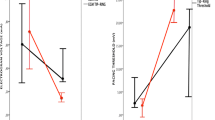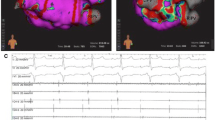Abstract
Linear lesions have been proposed for treatment of complex atrial arrhythmias including atrial macroreentry tachycardia and compartmentalization in atrial fibrillation.
Aim: To judge the effectiveness of a given lesion design, definite endpoints are necessary to ascertain the completeness of the line of block produced.
Methods and results: We report validation criteria for long linear lesions in the right atrium in 42 pts, that combine both conventional and 3D mapping information (CARTO). Transferring from the validation of bi-directional block of the cavotricuspid isthmus line for atrial flutter, we validated 2 additional long linear lesions in the right atrium (anterior line and intercaval line). In addition to a complete isthmus line in all 42 pts, in 28 pts a complete anterior line was achieved and validated by both conventional and CARTO criteria. A complete intercaval line was deployed in 11 pts with complete anterior and isthmus lines (with a characteristic shift for the intercaval line) and in 5 pts without a complete anterior line (without characteristic shift).
Conclusions: Conventional catheters placed at strategic locations on opposite sides of the intended ablation line, can depict a sudden characteristic change in the activation sequence. Using a combination of both techniques, deployment and validation of long linear lesion can be facilitated.
Similar content being viewed by others
References
Shah D, Jais P, Takahashi A, Hocini M, Peng JT, Clementy J, Haïssaguerre M. Dqual-loop intra-atrial reentry in humans. Circulation 2000;101:631–639.
Ernst S, Schlüter M, Ouyang F, Khanedani A, Cappato R, Hebe J, Volkmer M, Antz M, Kuck KH. Modification of the substrate for maintenance of idiopathic human atrial fibrillation. Circulation 1999;100:2085–2092.
Avitall B, Helms RW, Chiang W, Periman BA. Nonlinear atrial radiofrequency lesions are arrhythmogenic: A study of skipped lesions in the normal atria (abstract). Circulation 1995;92:I-265.
Cosio FG, Lopez-Gill M, Giocolea A, Arribas F, Barroso JL. Radiofrequency ablation of the inferior vena cava-tricuspid valve isthmus in common atrial flutter. Am J Cardiol 1993;71:705–709.
Poty H, Saoudi N, Nair M, Anselme F, Letac B. Radiofrequency catheter ablation of atrial flutter: Further insights into the various types of isthmus block: Application to ablation during sinus rhythm. Circulation 1996;94:3204–3213.
Nakagawa H, Lazzara R, Khastgir T, Beckman KJ, McClelland JH, Imai S, Pitha JV, Becker AE, Arruda M, Gonzales MD, Widman LE, Rome M, Neuhauser J, Wang X, Calame JD, Goudeau MD, Jackman WM. Role of the tricuspid annulus and the eustachian valve/ridge on atrial flutter. Circulation 1996;94:407–424.
Pappone C, Oreto G, Lamberti F, Vicedomini G, Loricchio ML, Shpun S, Rillo M, Callabro MP, Conversano A, Ben-Haim SA, Cappato R, Chierchia S. Catheter ablation of paroxysmal atrial fibrillation using a 3D mapping system. Circulation 1999;100(11):1203–1208.
Shah DC, Haïssaguerre M, Jais P, Fischer B, Takahashi A, Hocini M, Clementy. Simplified electrophysiologically directed catheter ablation of recurrent common atrial flutter. Circulation 1997;96:2505–2508.
Nakagawa H, Shah N, Matsudaira K, Overholt E, Chandrasekaran K, Beckman KJ, Spector P, Calame JD, Rao A, Hasdemir C, Otomo K, Wang Z, Lazarra R, Jackman WM. Characterization fo reentrant circuit in macroreentrant right atrial tachycardia after repair of congenital heart disease: Isolated channels between scars allow “focal” ablation. Circulation 2001;103(5):699–709.
Ernst S, Ouyang F, Schneider B, Kuck KH. Prevention of atrial fibrillation by complete compartmentalization of the left atrium using a catheter technique. J Cardiovasc Electropysiol 2000;11:686–690.
Ernst S, Ouyang F, Loeber F, Antz M, Kuck KH. Catheterinduced linear lesions in the left atrium in patients with atrial fibrillation—an electroanatomical study. JAmer Coll Cardiol 2003:42(7).
Author information
Authors and Affiliations
Corresponding author
Rights and permissions
About this article
Cite this article
Ernst, S., Ouyang, F., Clausen, C. et al. A Model for In Vivo Validation of Linear Lesions in the Right Atrium. J Interv Card Electrophysiol 9, 259–268 (2003). https://doi.org/10.1023/A:1026300911069
Issue Date:
DOI: https://doi.org/10.1023/A:1026300911069




